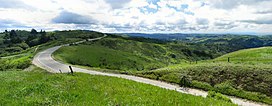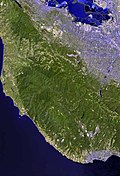Santa Cruz Mountains
| Santa Cruz Mountains | |
|---|---|
 Skyline Blvd runs through the Santa Cruz Mountains, here in Portola Valley. | |
| Highest point | |
| Peak | Loma Prieta Peak |
| Elevation | 3,786 ft (1,154 m) |
| Geography | |
Location of Santa Cruz Mountains in California [1] | |
| Country | United States |
| State | California |
The Santa Cruz Mountains, part of the Pacific Coast Ranges, are a mountain range in central California, United States. They form a ridge along the San Francisco Peninsula, south of San Francisco, separating the Pacific Ocean from San Francisco Bay and the Santa Clara Valley, and continuing south, bordering Monterey Bay and ending at the Salinas Valley. The range passes through San Mateo, Santa Clara and Santa Cruz counties, with the Pajaro River forming the southern boundary.
The northernmost portion of the Santa Cruz Mountains is known as Montara Mountain, north of Half Moon Bay Road (California State Route 92); the middle portion is known as the Sierra Morena, which includes a summit called Sierra Morena,[2] and extends south to a gap at Lexington Reservoir; south of the gap the mountain range is known as the Sierra Azul.[3][4]
The highest point in the range is Loma Prieta Peak 3,786 feet (1,154 m), near which is the epicenter of the 1989 Loma Prieta earthquake. Other major peaks include Mount Umunhum 3,486 feet (1,063 m), Mount Bielawski 3,231 feet (985 m), El Sombroso 2,999 feet (914 m), Eagle Rock 2,488 feet (758 m), Black Mountain 2,800 feet (850 m), and Sierra Morena 2,417 feet (737 m). The San Andreas Fault runs along or near the ridge line throughout the range. The east side of the mountains drops abruptly towards this fault line especially near Woodside and Saratoga.
For much of the length of the range on the San Francisco Peninsula, State Route 35 runs along its ridge, and is known as "Skyline Boulevard". The major routes across the mountains are (from north to south) SR 92 from Half Moon Bay to San Mateo, SR 84 from San Gregorio to Redwood City, SR 9 from Santa Cruz to Saratoga, SR 17 from Santa Cruz to Los Gatos, SR 152 from Watsonville to Gilroy, SR 129 from Watsonville to San Juan Bautista, and US Highway 101 from Salinas to Gilroy.
The Santa Cruz Mountains have been a legally defined American Viticultural Area since 1981. Wine has been produced here since at least the 1840s. The Santa Cruz Mountain AVA has emerged as premier producer of top wines, recognized in the historic Judgment of Paris on May 26, 1976.[5] There are over 30 wineries located in this area.
Geology
The Santa Cruz Mountains are largely the result of compressive uplift caused by a leftward bend of the San Andreas Fault. The Salinian Block basement rocks are overlain by Miocene rock strata of the Lompico Sandstone, the Vaqueros Sandstone and the Santa Margarita Formation.
Ecology


The Santa Cruz Mountains are a region of large biological diversity, encompassing cool, moist coastal ecosystems as well as warm, dry chaparral. Much of the area in the Santa Cruz mountains is considered temperate rainforest. In valleys and moist ocean-facing slopes some of the southernmost coast redwoods grow, along with coast Douglas-fir.[6] coast live oak, Pacific madrone, Pacific wax myrtle, big leaf maple, California bay laurel, and California black oak also occur in the Santa Cruz Mountains. There do exist several small and isolated stands of old-growth forest, most notably at Henry Cowell Redwoods and Portola Redwoods State Parks and one sizeable old-growth redwood forest at Big Basin. At higher elevations and on sunny south slopes a more drought-resistant chaparral vegetation dominates: manzanita, California scrub oak, chamise, and chaparral pea. Spring wildflowers are also widespread throughout the range.
The area welcomes a tremendous number of species of birds. (see: bird list). Black-tailed deer, a subspecies of mule deer are common, as are western gray squirrels, chipmunks and raccoons. Periodic sightings of black bears indicate they frequent the mountains or wander north from Big Sur, where black bears are established [citation needed]. Foxes, coyotes, bobcats, cougars and human-introduced Virginia opossums also inhabit the region but are rarely seen. Rattlesnakes are also inhabitants, mostly in the high, dry chaparral.
Climate


The Santa Cruz Mountains have a Mediterranean type climate typical of most of California, with the majority of the annual precipitation falling between November and April. According to the National Weather Service, this totals more than 50 inches (127 cm) annually. Heavy summer fogs frequently cover the western ocean-facing slopes and valleys, resulting in drizzle and fog drip caused by condensation on the redwoods, pines, and other trees, which sustains the moisture-loving redwood forests. Due to a rain shadow effect, precipitation on the eastern side of the range is significantly less, about 25 inches (64 cm) a year. Snow falls a few times a year on the highest ridges, and more rarely the higher valleys receive light dustings.
The National Weather Service's cooperative weather stations in the mountains have included Black Mountain 2WSW – average annual rainfall 36.65 inches (931 mm), maximum annual rainfall 80.66 inches (2,049 mm), average annual snowfall 0.7-inch (18 mm), maximum annual snowfall 8.0 inches (200 mm); Los Gatos 5SW – average annual rainfall 26.45 inches (672 mm), maximum annual rainfall 103.23 inches (2,622 mm), average snowfall 2.7 inches (69 mm), maximum annual snowfall 9.0 inches (230 mm); and Wrights – average annual rainfall 46.09 inches (1,171 mm), maximum annual rainfall 87.65 inches (2,226 mm), average annual snowfall 1.2-inch (30 mm), maximum annual snowfall 10.6 inches (270 mm). No temperature records were kept at these stations.[7]
The Santa Cruz Mountains are subject to sharp diurnal temperature fluctuations. The highs and low within a 24-hour period are ~20–30 °F apart on average [8] but can be as much as 50 °F apart during heat waves depending on location. There is also considerable variation in temperature from day to day in both Summer and Winter with shifting wind directions, and fluctuations in the degree or marine influence.
Average winter highs range from the low 60's °F (~16–18 °C) [8] in the coastal valleys to the upper 50's °F (~14–15 °C) in the valleys further inland.[9] Average Winter overnight lows are a function of topology and can vary significantly, from an average low of 37 °F (~3 °C) [8] in the valleys to ~42–44 °F (~6–7 °C) [10] in the thermal belts above the inversion layer where cold air can readily drain off the slopes.
Thermal inversions occur primarily during the Winter when cool air sinks and gets trapped in the valleys at night, often leading to frost and occasional freezes. Higher elevations above the inversion layer usually stay mild with frost being a rare occurrence. The USDA has recently re-classified the hardiness zones for the higher elevations as USDA 10a to 10b to reflect the lack of frost at those locations.[11] However, while the higher elevations are less prone to frost, they are also more likely to experience occasional snow accumulations. The valleys in contrast are rated USDA 9b with some locations as cold as 9a due to the lack of cold air drainage.
Summer temperatures regularly reach highs in the 80s °F (~28–30 °C) [8] with nighttime usually in the upper 40s to lower 60s °F (~9–18 °C) depending on elevation, distance from the ocean and degree of marine inversion present. Summer weather is dominated by a persistent Marine layer that can vary in depth. When the inversion layer drops below 300–500 feet, the higher elevations are deprived of marine influence and will often be subject to intense heat waves with daytime temperatures in the 95-105F (~35–40 °C) range and extreme low humidity with elevated overnight lows that offer little relief from the heat. Such conditions can lead to fires that can occur even before the official State of California fire season starts in the Fall. An example of such a fire was the 2009 Lockheed Fire and the Summit Fire in 2008 .
Recreation

The Santa Cruz Mountains are home to an abundance of parks and protected open spaces, notable among them is California's oldest state park: Big Basin Redwoods State Park. Other state parks include Castle Rock State Park, Portola Redwoods State Park, Butano State Park, The Forest of Nisene Marks State Park, McNee Ranch State Park and Henry Cowell Redwoods State Park with its famous Redwood Grove walking trail. Additional land is protected by the Midpeninsula Regional Open Space District, the Peninsula Open Space Trust (POST), the Sempervirens Fund and local county parks districts. Hiking, horse-riding, mountain biking, rock climbing, and backpacking are popular activities. There are two long-distance trails in the range: the Skyline-to-the-Sea Trail, which winds 38 miles (58 km) from Castle Rock State Park through Big Basin to the Pacific Ocean, and the Bay Area Ridge Trail, which, while still disjointed, here roughly parallels Skyline Boulevard along the spine of the range. There also exist several backcountry campsites in many of the state parks that enable long distance multi-day outings. Castle Rock State Park has open rock faces suitable for rock climbing and bouldering.
Cultural history

The previous historic Old Almaden Winery was located on the eastern slopes of the Santa Cruz Mountains. It was the first commercial winery in California, planting high quality European (French) varietal vines.[12]
Film director Alfred Hitchcock and his wife Alma had their primary residence near Scotts Valley, the Cornwall Ranch, purchased in September 1940.[13]
In 1965, science fiction author Robert A. Heinlein constructed a home in Bonny Doon, and lived there until shortly before his death in 1988.[14][15]
References
- ^ "Santa Cruz Mountains". Geographic Names Information System. United States Geological Survey, United States Department of the Interior. Retrieved 2009-05-03.
- ^ "Morena Sierra". Geographic Names Information System. United States Geological Survey, United States Department of the Interior. Retrieved 2010-12-01.
- ^ John Hunter Thomas (1991). Flora of the Santa Cruz Mountains of California: A Manual of the Vascular Plants. Stanford University Press. p. 5. ISBN 978-0-8047-1862-2. Retrieved 2010-10-25.
- ^ Luther A. Ingersoll (1893). Henry D. Barrows (ed.). A memorial and biographical history of the coast counties of Central California. Lewis Publishing Company. p. 190. Retrieved 2010-10-25.
- ^
Taber, George M. (2005). Judgement of Paris: California vs. France and the Historic 1976 Paris Tasting That Revolutionized Wine. Scribner. ISBN 978-0-7432-4751-1.
{{cite book}}: Cite has empty unknown parameter:|coauthors=(help) - ^ James R. Griffin (September 1964). "A New Douglas-Fir Locality in Southern California". Forest Science: 317–319. Retrieved 2015-05-03.
- ^ Central California
- ^ a b c d Ben Lomond Climate Averages
- ^ Los Gatos Climate Averages
- ^ Weston Road Weather
- ^ USDA Interactive Hardiness Map
- ^ [1] Archived 2010-06-01 at the Wayback Machine
- ^ Hitchcock had Link to Santa Cruz Co
- ^ http://www.nndb.com/people/710/000023641/, including quoted passage from San Francisco Chronicle columnist Herb Caen.
- ^ http://www.heinleinsociety.org/rah/history/bonnydoon1.html
External links
- http://www.hiway17.com Community website
- peaklist.org Santa Cruz Mountains ranked by prominence
- summitpost.org Santa Cruz Mountains entry
- Santa Cruz Mountains on the Santa Cruz Wiki
- Santa Cruz Mountains
- California Coast Ranges
- Mountain ranges of the San Francisco Bay Area
- Mountain ranges of San Francisco, California
- Mountain ranges of San Mateo County, California
- Mountain ranges of Santa Cruz County, California
- Mountain ranges of Santa Clara County, California
- Mountain ranges of Monterey County, California
- Mountain ranges of San Benito County, California
- Subregions of the San Francisco Bay Area
- Mountain ranges of Northern California



